The Microsoft Surface Book Review
by Brett Howse on November 10, 2015 8:00 AM ESTCPU and Storage Performance
The Surface Book comes with just two CPU options. The base model is an Intel Core i5-6300U, and the top end model moves to a Core i7-6600U. The i5 is a dual-core processor, with a base frequency of 2.4 GHz and a turbo frequency of 3 GHz, and it has 3 MB of cache available. The i7 bumps the base frequency to 2.6 GHz, and the turbo to 3.4 GHz, which is a 13% increase in turbo. The i7 also has 4 MB of cache. Both have the same Intel HD Graphics 520, although the i7 has a maximum GPU frequency of 1.05 GHz versus 1.0 GHz on the i5. Both are 15-Watt processors.
The Surface Book can be had with up to 16 GB of memory, which should be plenty for most tasks that are done on an Ultrabook. Memory is dual-channel LPDDR3-1866 that is soldered into the top half of the unit. This should be plenty to handle virtualization of small workloads, and with the Surface Book coming with Windows 10 Pro, Hyper-V is an option.
We’ve already taken a look at what Skylake can bring to the tablet in terms of performance with the Surface Pro 4. Due to the improvements Microsoft made to cooling, as well as enhancements with Skylake, the Surface Pro 4 has throttling in check, and that carries through to the Surface Book as well. The initial Surface Book made available for review was the i5-6300U model, but then at the end of October, Microsoft was able to supply the i7-6600U with dGPU, 16 GB of memory, and 512 GB of storage as well, so we will be able to put the Surface Book through all of its paces across all of the different models.
For comparisons, I’ve sampled several similar devices for the graphs, and if anyone would like to compare the Surface Book against anything we’ve tested, please use the Bench link at the top of the page. At the launch of the Surface Book, Microsoft compared it to the 13-inch Retina MacBook Pro. On the CPU side, the 13-inch MacBook Pro uses 28-Watt processors, and they include Iris graphics (but no eDRAM – at least yet), so in terms of CPU performance the Surface Book is not going to be able to compete at the same level with only half of the TDP available. We have not had any of the recent MacBook Pro models in for review though, so we won’t be able to compare it directly.
PCMark
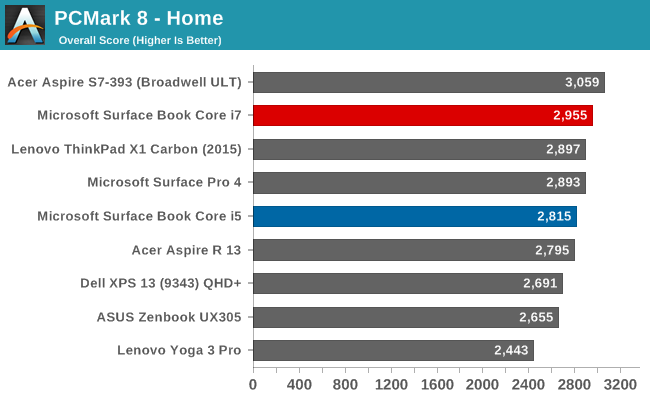
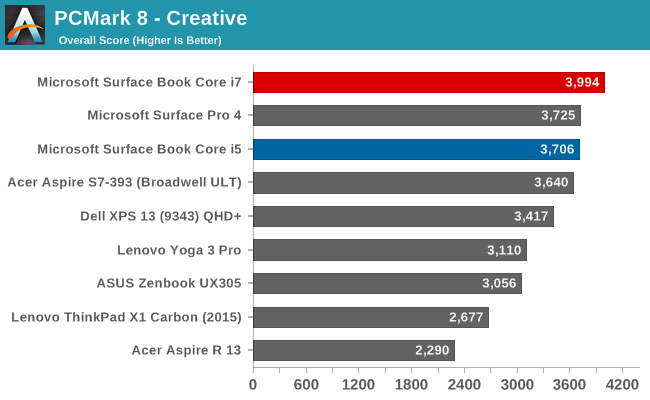
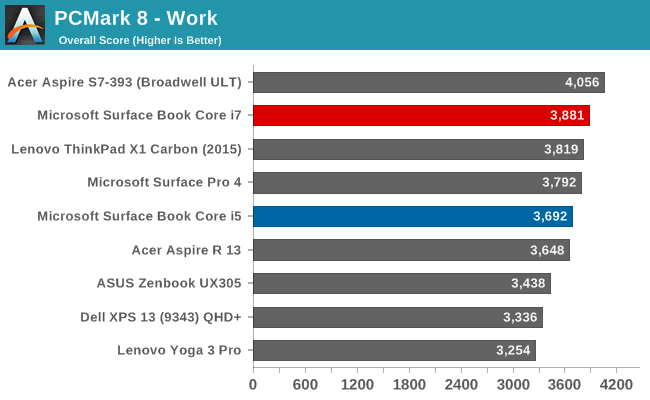
PCMark attempts to simulate real world workloads in several tests. Pretty much all factors of the device are tested, including storage, CPU, memory, and graphics. Skylake does pretty well in these tests, and while the Surface Book with Core i7 is not always the fastest, it is the fastest of any high resolution device.
Cinebench
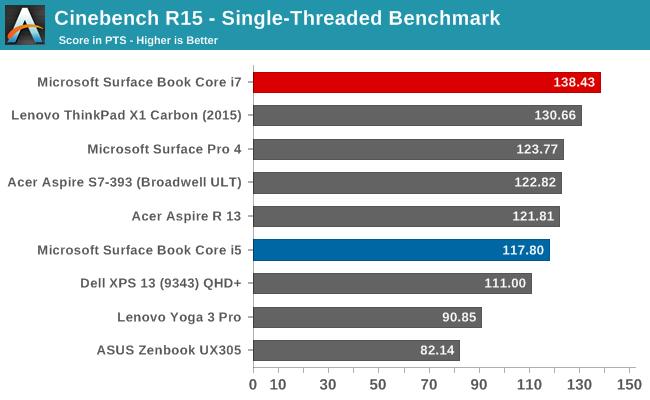
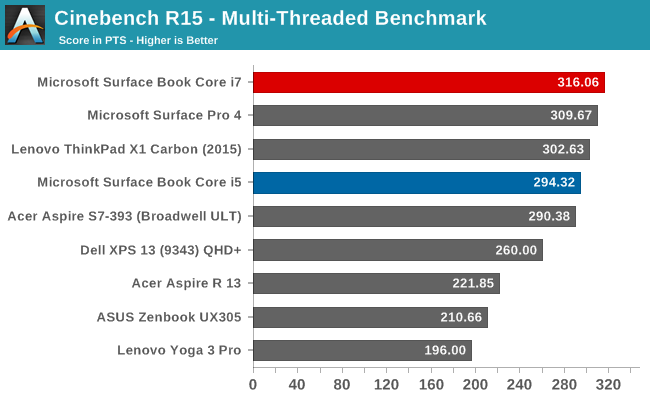
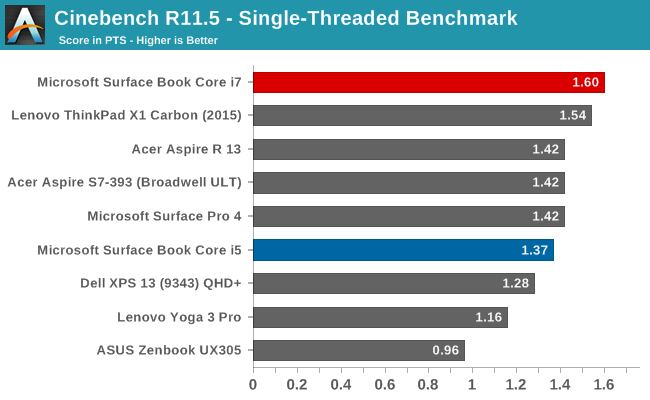
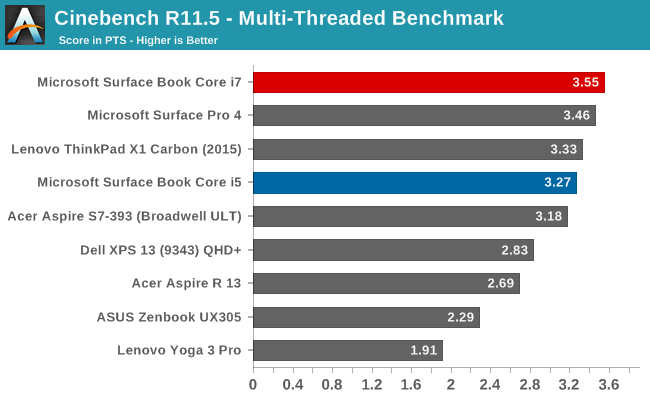
Cinebench performs rendering on the CPU, and more MHz and more cores can make a big difference on this test. Skylake does well here, especially on the multi-threaded workloads, but the i7-6600U shows a nice gain over the outgoing Broadwell Core i7 models.
x264
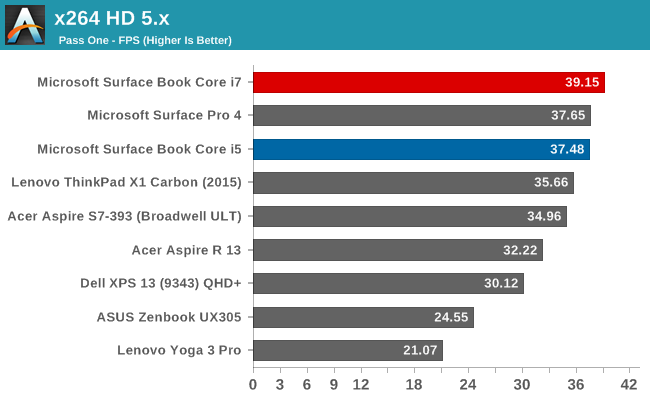

This test converts some video files, and much like Cinebench, it’s a mostly CPU bound test. Skylake does very well at this, but surprisingly the Core i7 model was slightly slower than the i5 on at the second pass.
Web Benchmarks
Browsing the web is something all of us do, so performance here is important. In the end, we can test JavaScript performance, but this is a test of more than just the CPU, since much of the performance is derived from the browser’s scripting engine. Previous to Windows 10, we had used Google Chrome since IE 11 was not representative in terms of performance, but with Edge now available in Windows 10, we’ve moved to that browser. Some of the tests will show an increase over Chrome with Edge, and some will show a decrease, so I’ve labeled all of the graphs to show which browser was used.
In addition, Intel’s Speed Shift is not yet available in Windows 10, so the scores do not have this enabled except where indicated to show the difference in the upcoming build of Windows 10. Once the patch is confirmed to be out, I’ll update Bench with the new values.

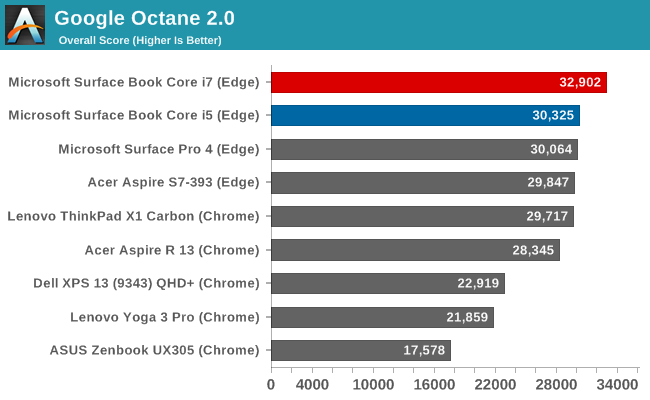
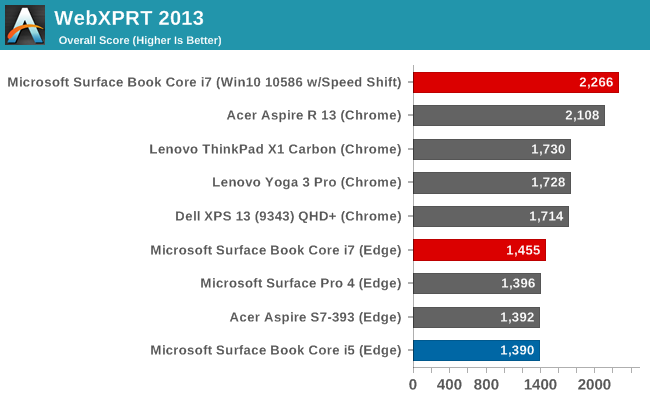
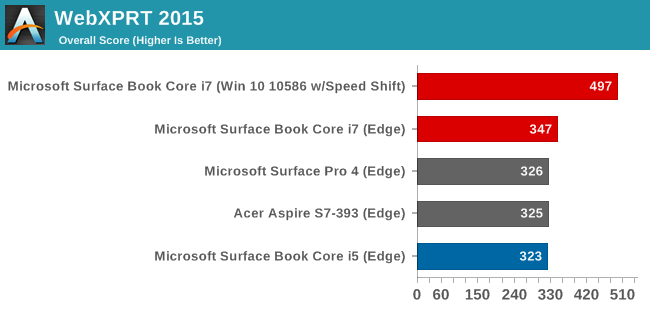
Like with the Surface Pro 4, performance on these tests is very good, with Skylake being able to outclass all of the previous generations of processors from Intel. We’ve already given you a preview of how this well change too when Speed Shift does get enabled on Windows 10, so expect these scores to go up a bit more too.
Storage Performance
With the Surface Pro 4, and Surface Book, Microsoft has moved to the cutting edge of storage technology. All of the flash storage is now based on NVMe, and the use of PCI-E 3.0 gives the system significantly more bandwidth than SATA ever could. While this is not quite the jump a SSD was to a HDD, for SSDs, it’s a big jump in overall performance.
On the Surface Pro 4 we had a 256GB Toshiba XG3 NVMe drive, and it was somewhat hampered by the number of NAND dies available. With the Surface Book that was provided for review, it is the full 512 GB model, and the extra NAND dies make a huge difference, especially on the write speeds. We see a tripling of the sequential write speed, up to 1.5 GB/s, and pretty much all of the other write speeds are doubled. This is some seriously fast storage, and any work with large files is almost comically fast.
There is some bad news though. On notebooks, it is not uncommon to see components dual-sourced from multiple vendors. This can be for a number of reasons, and recently we have seen it in the iPhone 6s which sources it’s SoC from two vendors. Microsoft has gone down this road with the Surface Book, meaning there are going to be two versions of SSD available. The first is the very fast Toshiba that we’ve just seen, but the second is not quite what I would have expected in a high end device.
Microsoft has gone with the Samsung PM951, which is similar to the Samsung SM951 that we’ve reviewed in the past. It is still a PCIe 3.0 x4 NVMe drive, but there is one crucial difference between it and the SM951. The PM951 uses Triple-Level Cell (TLC) NAND rather than Multi-Level Cell in the SM951. TLC has some drawbacks, which are lower durability and slower write speeds. I’ll recommend reading our TLC primer to get into the technical reasons for this, but I have some concerns with TLC NAND being used in the Surface Book in particular, mostly because of its position in the marketplace.
You can see that read speeds are still quite good, even surpassing the Toshiba some of the time, but write speeds are quite a bit lower. In particular, the sequential writes can be less than half the speed of the XG3 drive. This can be compensated for by using some SLC (Single-Level Cell) as a cache, but it does not appear that the PM951 has any caching available to it.
Also, these speeds are tested with the 512 GB drive, and lower capacity drives are going to have slower performance across the board due to the lack of parallelization of the NAND itself.
Let’s take a look at another test though. PCMark 8 uses traces from real-world applications to create their own storage test.
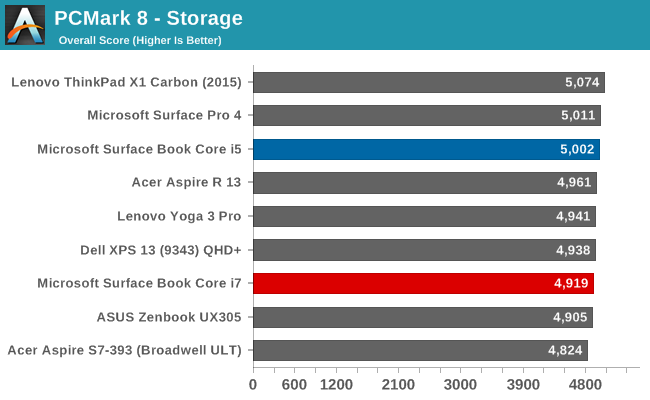
Here we can see that the Samsung drive actually scores a bit higher than the Toshiba. PCMark 8 tends to lump SSDs together, almost regardless of absolute performance. For many tasks, you just are not going to notice the slower write speeds of the Samsung drive. It would only be in cases where you are writing very large files to the drive, and where you are not already limited by another bottleneck (such as a USB drive so some other external device) where you are going to notice.
Summing the storage up, we have a situation that is not ideal. It’s fine to source from different vendors, but the performance differences between the two devices are quite substantial, let alone the long term durability of the TLC NAND. It was a decision done for the wrong reasons. It’s great that Microsoft has paid enough attention to storage to move to NVMe based drives, but then they have created a headache for themselves by sourcing drives with such different performance levels. If they had used the more expensive Samsung SM951, I don’t think there would be a discussion here. Many customers may not notice the speed differences, but that does not excuse the decision. Some customers will notice. On a premium device like the Surface Book, I would expect only the best, and while the drive may meet their internal performance levels, a cacheless TLC based SSD in a premium device is not necessary.


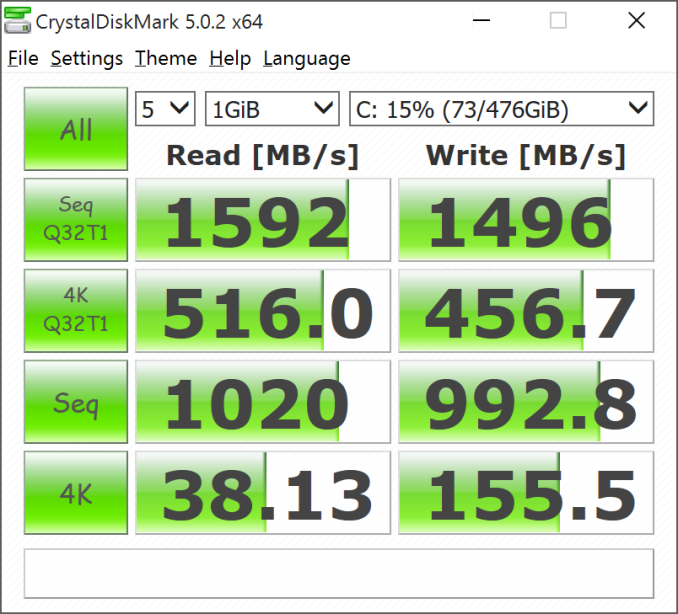









249 Comments
View All Comments
s.yu - Sunday, November 15, 2015 - link
Many ultrabook displays cover the same color gamut with just as good color and greyscale Delta E They're calibrated, they just don't advertise it so much. You're fooled by MS. As for 13.5" 3:2, 14" 16:9 is similar and you could get more done on the new XPS15's 15.6" screen, with more screen and less bezel.450nits, yeah that's unique, however quite useless. It's like Xperia Z4's ~800nits panel, nobody needs that much and sunlight visibility ends up slightly worse than S6's panel which topped at ~600nits. I just got a new panel for my notebook because the old one leaked liquid crystal. It's much brighter and sometimes seemed too vibrant (I admit it's 95% AdobeRGB) when displaying some saturated colors, which reminded me how much the old one's backlight aged in 3 years, but when I calibrated it, Spyder showed that it was only 194nits, I couldn't believe it as I was almost sure it's over 250nits just looking at it with my bare eyes, so I'm positive that I'll never need anything past 250nits on a notebook.
The narrow gamut on the MSB however, couldn't be made up for.
ninjacut - Tuesday, November 10, 2015 - link
After coming from Dell, Lenovo, HP I always wanted Microsoft to build their own laptop. So the Surface Book announcement was very exciting.The good technical part was covered well by Anandtech, with some gaps around pen, etc. with some obvious Apple bias creeping. But I don't agree with the conclusion. After the Nov 2 update, I have no issues with the unit. On the contrary, having used the device last 2 weeks made me realize how productive this device is.
I am impressed with the keyboard, touchpad, pen very superior to any earlier experience. The display is awesome in size and richness. Biggest surprise was how light is the display unit in tablet mode, hard to realize it has a Core i7 running with 8GB and 256 SSD.
In one of my recent meetings, I just removed the display and handed over to the client to go through some dashboards and he was flabbergasted. The meeting turned out very positive.
This unit is a keeper, and if the updates come in regularly I never will buy any other OEM laptop for sure
Cobalt Wraith - Tuesday, November 10, 2015 - link
Dito, in the same book and have not encountered any of the allegedly prevalent problems.s.yu - Wednesday, November 11, 2015 - link
Go on Amazon to read the amazing number of 1 star reviews. Some complained a great deal but gave 3-4 stars out of decency.solipsism - Tuesday, November 10, 2015 - link
1) I'm glad to see that the trackpad feel and firmware is decent.2) I don't know if it comes to down to a lack of volume or a lack of expertise, but MS's horrible use of space on their logic boards repeatedly wastes a shitload of space that could reduce the device volume, reduce the weight, and/or allow for a larger battery.
nikon133 - Tuesday, November 10, 2015 - link
Leaving space for next gen improvements? :)nerd1 - Tuesday, November 10, 2015 - link
Returning mine soon. May get thinkpad 460 instead.Teknobug - Tuesday, November 10, 2015 - link
Got my eye on HP Spectre x360 or Dell 13 7000, but saw the Yoga 3 Pro too.nerd1 - Tuesday, November 10, 2015 - link
x360 is a really nice device. Good build, nice screen (even 1080p), good keyboard and big battery. I don't like the weird trackpad (still usable though) and garbage synaptics pen though.It will be great if HP release a new x360 with 3:2 screen and wacom AES pen. I'd gladly pay $1500 if they make one.
GeorgeH - Tuesday, November 10, 2015 - link
I'm going to be "that guy".1) Not putting any information about the competing laptops (esp. CPU) makes the performance comparisons almost completely worthless, especially when you consider how sensitive U-series CPUs can be to their thermal solution and firmware configuration. I could of course assume that they are specced as tested in previous AT reviews, but why should I be doing that work?
2) A “bunch of battery” doesn't just disappear (conclusions). Either the battery life indication is bad or you’re not properly conducting/controlling the test. The fact that the Book’s fans became audible and very hot when closed makes me guess that Windows detected an idle state and was doing background tasks. That further tells me that the tests probably weren’t properly controlled and have significant margins of error.
3) I understand you no longer have review models in house, but there’s absolutely no mention of different Windows versions (or CPU/hardware differences) in your battery life tests (I know Win8/10 are almost identical, but still). Could the Book’s superior life be due to Windows 10, OS optimization work Microsoft did specifically for the Book, generational CPU improvements, or something else? Any of those could have been addressed and/or tested for, but instead we get an insipid “dunno, GDDR5?” statement. When we consider the fact that the GPU is undockable and that this device is therefore uniquely capable of a rough analysis of how adding a discrete GPU affects laptop battery life, that kind of “hell if I know” statement is even more ludicrous.
This was an OK review when compared to the raft of “long forum post” reviews available elsewhere, but very disappointing in relation to what I expect from an AT review.